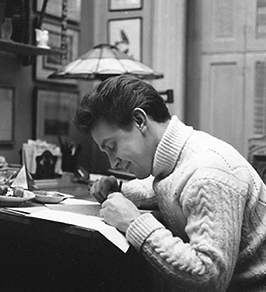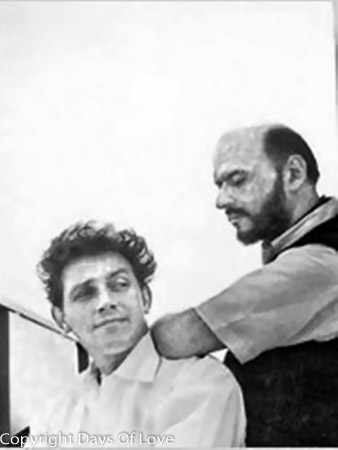Partner Leo Lerman
Queer Places:
Columbia University (Ivy League), 116th St and Broadway, New York, NY 10027
Osborne Apartments, 205 W. 57th St., New York, NY 10019, USA
 Gray
Foy (1922–2012) was a mid twentieth-century American artist who created a
visionary body of drawings from 1941 to 1975. His drawings are generally
divided into two phases. First, from 1941–48, the artist drew figurative
Surrealist landscapes and interiors. Then beginning in the late 1940s, he
concentrated on botanical subject matter, both naturalistic and imagined.[1]
Gray
Foy (1922–2012) was a mid twentieth-century American artist who created a
visionary body of drawings from 1941 to 1975. His drawings are generally
divided into two phases. First, from 1941–48, the artist drew figurative
Surrealist landscapes and interiors. Then beginning in the late 1940s, he
concentrated on botanical subject matter, both naturalistic and imagined.[1]
Born in 1922 in Dallas, Texas, Foy spent his youth in Los Angeles and
attended Los Angeles City College studying art and theater design.[2]
In the spring of 1946 he moved back to Dallas and enrolled at Southern
Methodist University (SMU) for a year, then transferred in Spring of 1947 to
Columbia University, New York City. In 1948, he met
Leo Lerman (a writer and
editor for various Condé Nast magazines and for Playbill magazine), who
became his lifelong mate.[3]
Foy and Lerman both were immersed in the literary, visual, and performing arts
and became fixtures of the New York City cognoscenti.[4]

When Foy first painted seriously in the early 1940s—just after entering
college—his opaque watercolors and oils were patterned after such Surrealists
as Max Ernst and Salvador Dalí. In compressed perspectives, stagelike scenes
of deserted cityscapes evoke a sense of dislocation and menace.
Beginning in 1943, Foy worked as a shipping expediter at the defense plant
Lockheed Vega Aircraft Corporation in Burbank, California. Using
standard-issue No. 2 pencils, he drew on procurement forms, depicting humanoid
figures that emerge from rocky outcroppings and are coincident with the
carnage of WWII.
Late in WWII, Foy began making larger format drawings. These hallucinatory
scenes became his first cohesive visions. After atomic bombs were dropped on
Japan, Foy responded by depicting human and animal inhabitants that reveal the
instability of their molecular basis. In his largest drawing of this period,
Dimensions (ca. 1945–46, Museum of Modern Art, New York),[5]
disparate figures and body parts, interior furnishings, vegetation, and
geometric shapes pulsate through a dense three-dimensional space where the
spatial trickery evokes that of M. C. Escher. When exhibited in 2008, the
New York Times wrote of Dimensions that "A pencil drawing by Gray
Foy, a little-known American artist born in 1923, is ... a scrambled,
congested, Dalí-like composition of body parts, still-life, architecture, and
landscape made with unbelievable refinement and microscopic detailing."[6]
In Foy’s midcentury universe, when humans seek the comfort of familiar
spaces they discover instead amorphousness, velocity, and weightlessness. The
pictures also reflect an affinity with the work of American Realists such as
Thomas Hart Benton and John Steuart Curry, whose tropes include the
overlapping vignettes of mural painting, often populated by figures whose
bodies are contoured or distorted to mimic their immediate setting.
Foy himself referred to his imagery as “hyper-realism,” stating in 1948 "I
may turn out to be a realist. After all, hyper-realism actually becomes the
supernatural.”[7]
A realist direction was fostered when his wartime employment ended and he
moved back to Dallas to renew his art studies at Southern Methodist with his
teachers Jerry Bywaters and Otis Dozier, both referred to as Lone Star
Regionalists.[8]
The Dallas Morning News said Foy's "provocative Surrealist pencil
drawings are the sensation of the current year-end exhibit at SMU."[9]
In September 1946, on his first trip to New York, the twenty-four-year-old
Foy took his portfolio to the influential art and literary publication View
magazine. In the fall of 1946, View published Untitled [Courtyard
with Morphing Figures] (1946), a seamless mix of the marvelous and the
monstrous and its appearance launched Foy’s career.[10]
Foy moved to New York in spring 1947, enrolling at Columbia University to
study studio art and art history, as well as anatomy and botany, two fields
that underpin much of his imagery.[11]
Soon, as in Pavel
Tchelitchew’s work, Foy began his own explorations merging plant life with
human features.
Foy sought gallery representation, and
R. Kirk Askew, Jr. became his first and
only dealer at Durlacher Bros. on 57th Street. Reviewers noted the rigor of
Foy’s scrutiny, describing his “microscopic vision”[12]
and “infinitesimal details glossed over by the average vision.”[13]
But by the time of his first one-person exhibition at Durlacher’s in April
1951, Foy had nearly abandoned Surrealist imagery and began concentrating
instead on the depiction of botanical organisms undergoing transitional
states. The New York Time's critic Stuart Preston wrote: "Foy's pencil
and brush spin out a tissue of delicacy and transparency, light enough to seem
to have settled on the paper like frost, strong enough to have netted in its
gossamer texture enough visual data about the plant forms to astound a
botanist."[14]
At his second one-person exhibition at Durlacher’s in 1957, his
observations of nature had matured, as evidenced by the intricate biological
invention in such works as Uprooted Plants (1955, Whitney Museum of
American Art[15]).
As his work evolved through the 1950s, the artist developed an understanding
of constant change in nature and honed his ability to depict such
metamorphosis.
In the three decades Foy was active, he found a way to convey his fertile
awareness of nature’s disorder as well as its order by refining his technical
prowess. Achieved by a delicate feathering technique, the edges of the
depicted organic matter gradually disappear as lighter and lighter pencil
pressure traverses the sheet.
About 1957 Foy began a series of related still lifes that involve leaves or
branches wrapped by human hands into clusters or sheaves, or assembled by
birds into nests. With its inner pinkish radiance and veined leaf surfaces,
Cluster of Leaves (ca. 1957), for example, quivers with the power of an
incubating egg. These drawings are metaphors for efforts to control the
untamed sprawl of natural vegetation.
In one group of works, Foy developed an additional illustrative mechanism,
preparing the drawing paper with a teeming texture, introducing earthy tones
and chlorophyll-like colorations. The activated surfaces simulate organic
matter such as soil incrustation, moldy walls, lichen-covered rocks, or pond
scum. In his book The Language of Ornament, art historian James
Trilling described the effect: "Gray Foy’s drawing evokes the richness of a
living coral reef, or the cheerfully haunted rocks that provide a background
to some of the finest Persian miniatures."[16]
After receiving a career-affirming John Simon Guggenheim grant in 1961,[17]
Foy concentrated on his largest drawing, The Third Kingdom (1961–62),
in which monochromatic greenish-umber tones convey the pro-longed activity of
organic upheaval. Working on fibrous Japanese paper, Foy spent a year trying
to illustrate elemental rock forms.
Such mature drawings focus on botanical and geological forms in the act of
transformation. They presage a modern-day concentration on ecological concerns
by excavating the progression of natural processes. Curator Stephen C. Wicks
explained: "The rich array of textures serves as a seductive skin beneath
which the artist’s plant forms appear to germinate, writhe, and wither. The
resulting effect underscores Gray Foy’s ability to create surrealist
compositions of uncommon craftsmanship and visionary form."[18]
The artist's mature compositions are his spirited attempts to render on paper
the mysteries of the biomass and origins of the life force.

Osborne Apartments
To supplement the limited income he received from his fine art pursuits,
Foy was actively involved in designing and illustrating magazine features in
Mademoiselle magazine, book jackets for numerous publishers, and album
covers for Long-Playing Records for Columbia Masterworks and Epic. Noteworthy
book jackets include first editions of J. R. Salamanca's Lilith (1961)
and Ray Bradbury's Something Evil This Way Comes (1962). Foy's design
of the cover for
Leonard Bernstein's recording of
Igor Stravinsky's
Le sacre du printemps (1957) was of such renown that it was reprinted
on the hundredth-anniversary commemorative DVD edition (2013). A selection of
such commercial illustrations is listed below.
My published books:


BACK TO HOME PAGE

- https://en.wikipedia.org/wiki/Gray_Foy
 Gray
Foy (1922–2012) was a mid twentieth-century American artist who created a
visionary body of drawings from 1941 to 1975. His drawings are generally
divided into two phases. First, from 1941–48, the artist drew figurative
Surrealist landscapes and interiors. Then beginning in the late 1940s, he
concentrated on botanical subject matter, both naturalistic and imagined.[1]
Gray
Foy (1922–2012) was a mid twentieth-century American artist who created a
visionary body of drawings from 1941 to 1975. His drawings are generally
divided into two phases. First, from 1941–48, the artist drew figurative
Surrealist landscapes and interiors. Then beginning in the late 1940s, he
concentrated on botanical subject matter, both naturalistic and imagined.[1]



